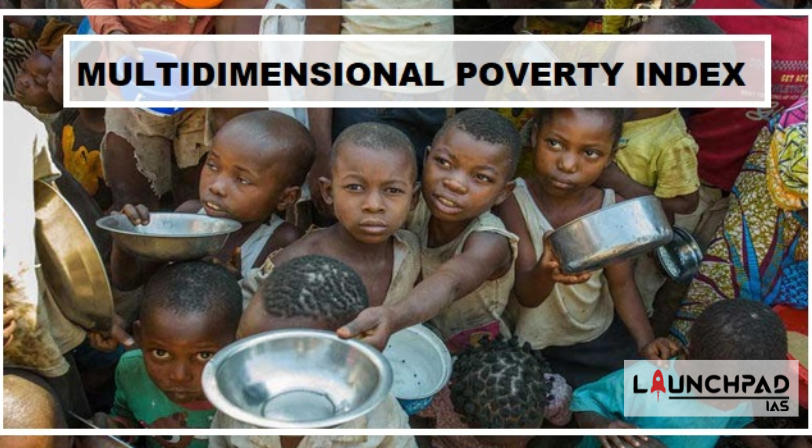About
- The Global Multidimensional Poverty Index (MPI) Report is produced by the United Nations Development Programme (UNDP) and the Oxford Poverty and Human Development Initiative (OPHI).
- The global Multidimensional Poverty Index (MPI) is an international measure of acute multidimensional poverty covering over 100 developing countries.
Report Indicators
- The Global MPI constructs a deprivation profile of each household and person through 10 indicators spanning health, education, and standard of living.
- All indicators are equally weighted within each dimension.
- The most common profile, affecting 3.9 percent of poor people, includes deprivations in four indicators: nutrition, cooking fuel, sanitation, and housing.

Calculating Multidimensional Poor
- The global MPI identifies people as multidimensionally poor if their deprivation score is 1/3 or higher.
- The MPI is calculated by multiplying the incidence of poverty and the average intensity of poverty.
- The MPI ranges from 0 to 1, and higher values imply higher poverty.
- By identifying who is poor, the nature of their poverty (their deprivation profile) and how poor they are (deprivation score), the global MPI complements the international $1.90 a day poverty rate, which was revised by the World Bank last month to $2.15 per day.
SDG Target
The Sustainable Development Goal target 1.2 is for countries to reduce at least by half the proportion of men, women, and children of all ages living in poverty in all its dimensions by 2030.
For India
Improvements:
- As many as 41.5 crore people exited poverty in India during the 15-year period between 2005-06 and 2019-21.
- Out of these, two-thirds exited in the first 10 years, and one-third in the next five years, according to the report.
- It shows that the incidence of poverty fell from 55.1% in 2005/06 to 16.4% in 2019/21 in the country.
- Deprivations in all 10 MPI indicators saw significant reductions as a result of which the MPI value and incidence of poverty more than halved.
The global significance of poverty reduction in India:
- Improvement in MPI for India has significantly contributed to the decline in poverty in South Asia.
- It is for the first time that it is not the region with the highest number of poor people, at 38.5 crore, compared with 57.9 crore in Sub-Saharan Africa.
State-wise data:
- Bihar, the poorest State in 2015/2016, saw the fastest reduction in MPI value in absolute terms.
- Of the 10 poorest States in 2015/2016, only one (West Bengal) was not among the 10 poorest in 2019/2021.
- The rest— Bihar, Jharkhand, Meghalaya, Madhya Pradesh, Uttar Pradesh, Assam, Odisha, Chhattisgarh and Rajasthan —remain among the 10 poorest.
Challenges
- The report notes that the ongoing task of ending poverty remains daunting.
- India has by far the largest number of poor people worldwide at 22.8 crore, followed by Nigeria at 9.6 crore.
- Two-thirds of these people live in a household in which at least one person is deprived of nutrition.
- There were also 9.7 crore poor children in India in 2019/2021- more than the total number of poor people, children and adults combined, in any other country covered by the global MPI.


